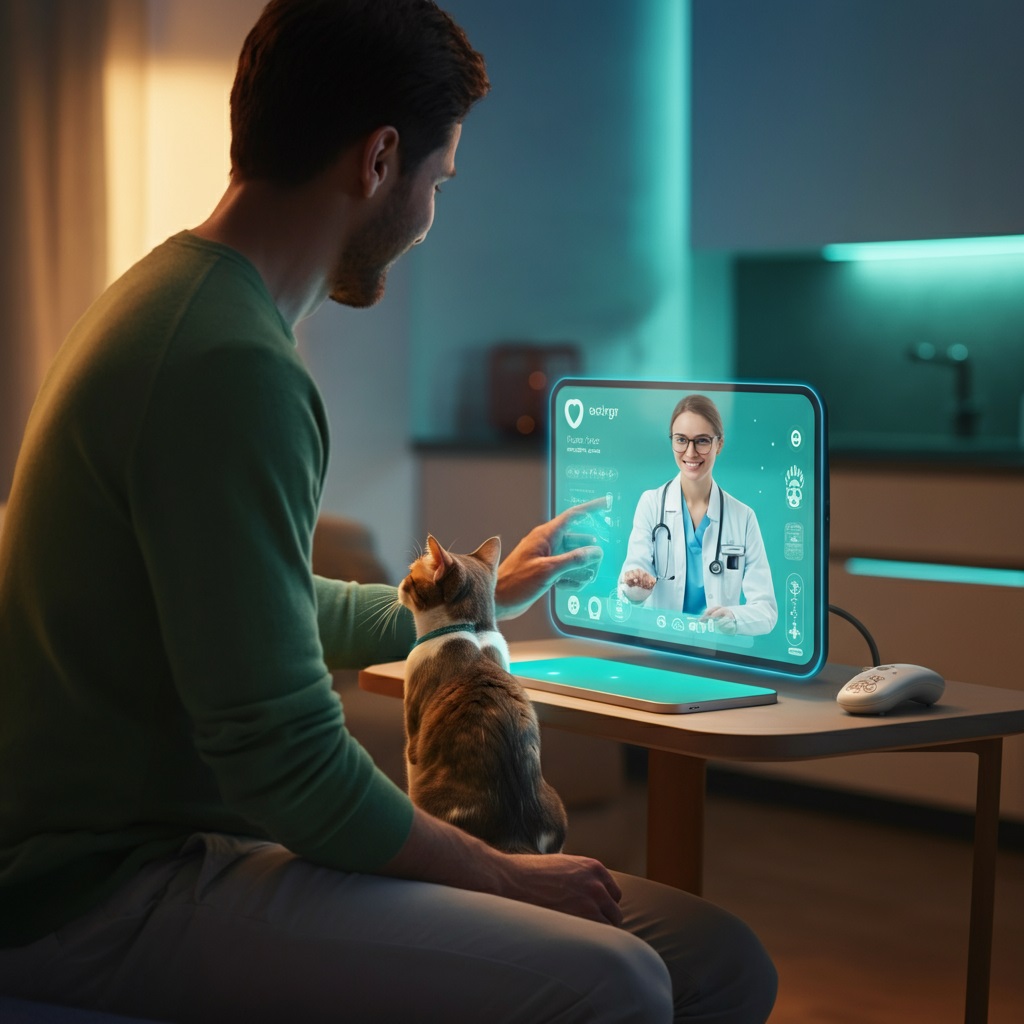
Pet owners have long dreaded the anxiety-inducing trip to the veterinary clinic. Between stressed animals, crowded waiting rooms, and the challenge of transporting sick pets, traditional vet visits can be overwhelming for both pets and their humans. Now, technology is revolutionizing pet healthcare through virtual veterinary consultations, making professional care more accessible than ever before.
Virtual veterinary care allows pet owners to connect with licensed veterinarians through video calls, phone consultations, and specialized telehealth platforms. This growing trend addresses many barriers to traditional veterinary care while maintaining the quality of professional medical advice your pet deserves.
How Virtual Vet Consultations Work
Virtual veterinary consultations typically begin with scheduling an appointment through a telehealth platform or your regular veterinary clinic’s online system. During the consultation, you’ll connect with a licensed veterinarian via video call, allowing them to observe your pet’s behavior and physical condition remotely.
The veterinarian will ask detailed questions about your pet’s symptoms, medical history, and current behavior patterns. They may request you to perform simple examinations under their guidance, such as checking your pet’s gums, feeling for lumps, or observing their gait. Many platforms also allow you to share photos or videos of concerning symptoms before or during the consultation.
Technology Requirements
Most virtual vet platforms require basic technology that most pet owners already have:
- A smartphone, tablet, or computer with a camera
- Stable internet connection
- The veterinary platform’s app or web browser access
- Good lighting in the room where you’ll conduct the consultation
Some platforms offer additional features like prescription management, medical record storage, and follow-up appointment scheduling directly through their systems.
What Conditions Can Be Treated Virtually
Virtual veterinary consultations work best for specific types of health concerns and situations. Understanding what can and cannot be addressed remotely helps set appropriate expectations for your online vet visit.
Suitable Conditions for Virtual Consultations
Behavioral Issues: Anxiety, aggression, excessive barking, or litter box problems can often be addressed through virtual consultations. Veterinarians can observe your pet’s behavior in their familiar environment and provide tailored advice.
Skin Conditions: Many dermatological issues can be evaluated through high-quality video or photos. Conditions like hot spots, rashes, or minor wounds may be assessed and treated with topical medications.
Digestive Concerns: Mild gastrointestinal issues, dietary questions, and nutrition consultations are well-suited for virtual visits. Veterinarians can provide guidance on diet changes and monitor improvement over time.
Medication Management: Adjusting dosages, discussing side effects, and monitoring chronic conditions like diabetes or arthritis can often be managed through virtual check-ins.
Wellness and Prevention: Routine wellness discussions, vaccination scheduling, parasite prevention, and general health maintenance can be effectively addressed online.
Limitations of Virtual Care
Virtual consultations cannot replace all aspects of traditional veterinary care. Physical examinations requiring hands-on assessment, diagnostic testing, surgical procedures, and emergency situations still require in-person visits.
Serious symptoms like difficulty breathing, seizures, suspected poisoning, or severe injuries require immediate in-person emergency care. Virtual veterinarians will recognize these situations and direct you to seek immediate physical veterinary attention.
Benefits of Virtual Veterinary Care
The rise of virtual veterinary consultations offers numerous advantages for both pets and their owners, addressing many pain points of traditional veterinary care.
Reduced Stress for Pets
Many pets experience significant anxiety during veterinary visits. The car ride, unfamiliar environment, and presence of other animals can create stress that may even interfere with accurate diagnosis. Virtual consultations allow pets to remain in their comfortable home environment, potentially providing veterinarians with more accurate behavioral assessments.
Increased Accessibility
Virtual care breaks down geographical barriers, particularly benefiting pet owners in rural areas with limited access to veterinary services. Pet owners no longer need to travel long distances for routine consultations or follow-up appointments.
Cost-Effective Care
Virtual consultations typically cost less than traditional in-person visits. Without the overhead costs of maintaining physical facilities, many virtual veterinary services can offer competitive pricing while maintaining quality care.
Continues after advertising
Convenient Scheduling
Many virtual platforms offer extended hours and more flexible scheduling options compared to traditional clinics. This flexibility accommodates pet owners with demanding work schedules or those dealing with pet emergencies outside regular business hours.
Continuity of Care
Virtual consultations enable more frequent check-ins for pets with chronic conditions. Rather than waiting months between appointments, pet owners can schedule regular virtual visits to monitor their pet’s progress and adjust treatments as needed.
Choosing the Right Virtual Veterinary Service
The growing popularity of virtual veterinary care has led to numerous platforms and services entering the market. Selecting the right service requires careful consideration of several factors.
Licensing and Credentials
Ensure that any virtual veterinary service employs licensed veterinarians in your state. Veterinary licensing requirements vary by location, and legitimate services will clearly display their veterinarians’ credentials and licensing information.
Services Offered
Different platforms specialize in various aspects of veterinary care. Some focus on routine wellness consultations, while others specialize in behavioral issues or chronic disease management. Choose a service that aligns with your pet’s specific needs.
Integration with Traditional Care
Consider how the virtual service integrates with your existing veterinary care. Some traditional veterinary clinics now offer virtual consultations as an extension of their services, providing seamless continuity between virtual and in-person care.
Technology and User Experience
Evaluate the platform’s ease of use, video quality, and additional features like prescription management or medical record storage. A user-friendly interface enhances the consultation experience for both you and your pet.
Prescription and Medication Services
Verify how the service handles prescription medications. Some platforms can send prescriptions directly to pet pharmacies, while others may require you to pick up medications from local veterinary clinics.
Preparing for Your Virtual Vet Visit
Successful virtual veterinary consultations require preparation similar to traditional vet visits, with some additional considerations for the online format.
Gather Information
Prepare a list of your pet’s symptoms, including when they started, their severity, and any changes over time. Take photos or videos of visible symptoms before the appointment, as these can be invaluable for veterinary assessment.
Create a Comfortable Environment
Choose a quiet, well-lit room where your pet feels comfortable. Natural lighting works best for video consultations, allowing the veterinarian to accurately assess your pet’s condition.
Have Supplies Ready
Keep basic supplies nearby, including your pet’s medications, thermometer if you have one, and any relevant medical records or previous test results.
Prepare Questions
Write down questions you want to ask during the consultation. Virtual visits may feel rushed, so having a prepared list ensures you don’t forget important concerns.
The Future of Virtual Veterinary Care
Virtual veterinary care continues to evolve rapidly, with new technologies and approaches constantly emerging. Artificial intelligence is beginning to assist with symptom assessment and triage, while improved camera technology enables more detailed remote examinations.
Integration with wearable pet technology shows promise for continuous health monitoring, allowing veterinarians to track pets’ vital signs and activity levels between consultations. This data could revolutionize preventive care and early disease detection.
Regulatory frameworks are also adapting to accommodate virtual care while maintaining professional standards. As these regulations mature, virtual veterinary services will likely become more standardized and widely accepted.
Read More👉 The Power of Pets in Elderly Care
Making Virtual Vet Care Work for Your Pet
Virtual veterinary consultations represent a significant advancement in pet healthcare accessibility and convenience. While they cannot replace all aspects of traditional veterinary care, they offer valuable solutions for many common pet health concerns.
Success with virtual veterinary care depends on choosing reputable services, understanding their limitations, and preparing thoroughly for consultations. By embracing this technology while maintaining relationships with traditional veterinary clinics for comprehensive care, pet owners can provide their animals with more accessible, stress-free healthcare options.
Consider exploring virtual veterinary options for your pet’s routine care, behavioral concerns, or chronic condition management. As this field continues to grow and improve, virtual consultations may become an essential component of comprehensive pet healthcare.



